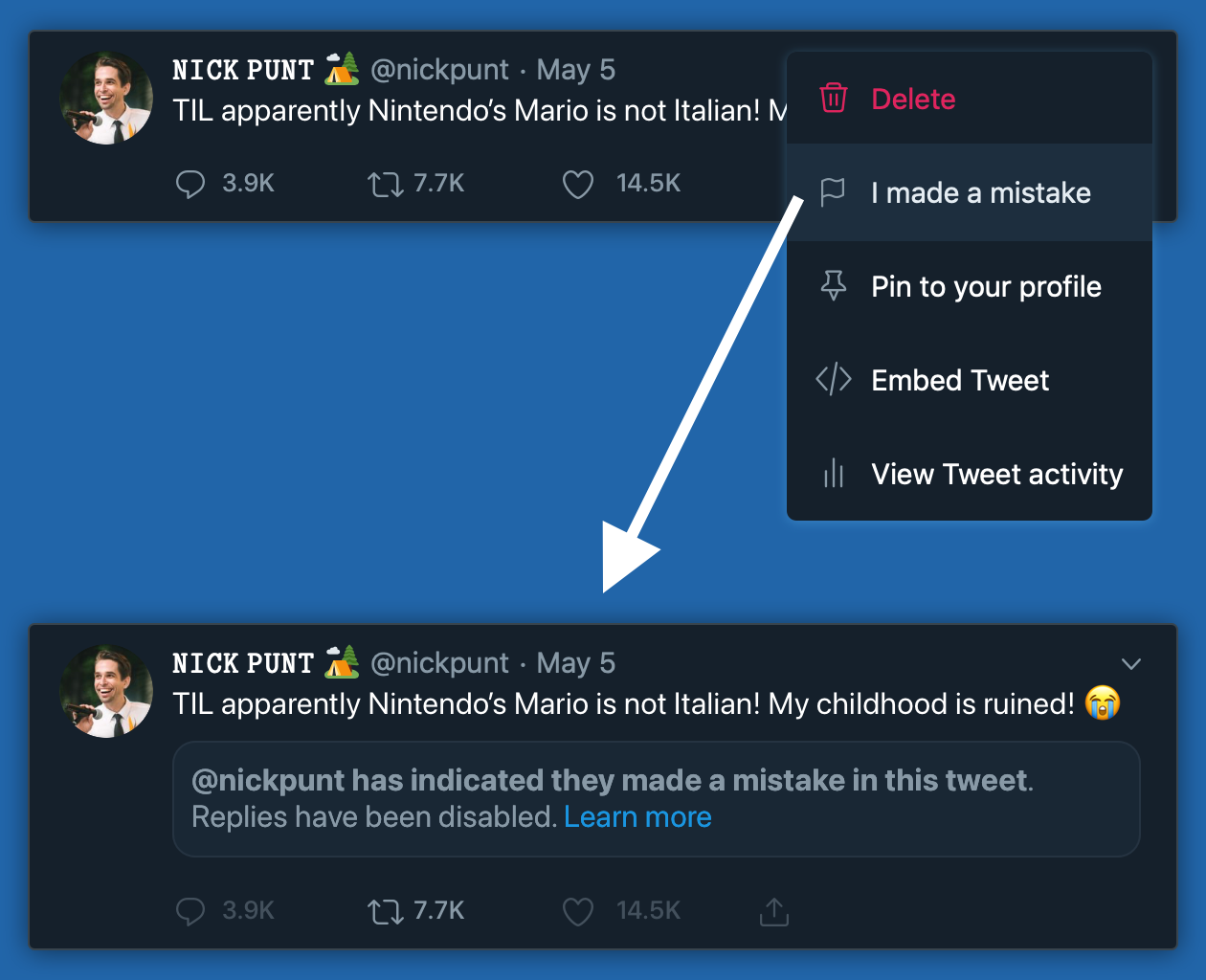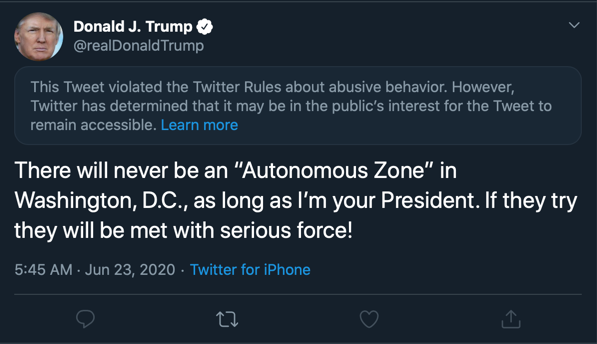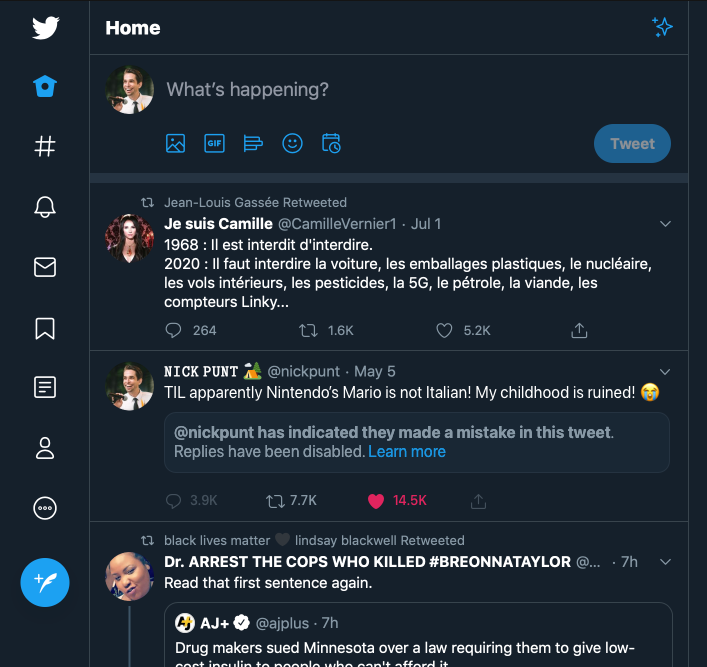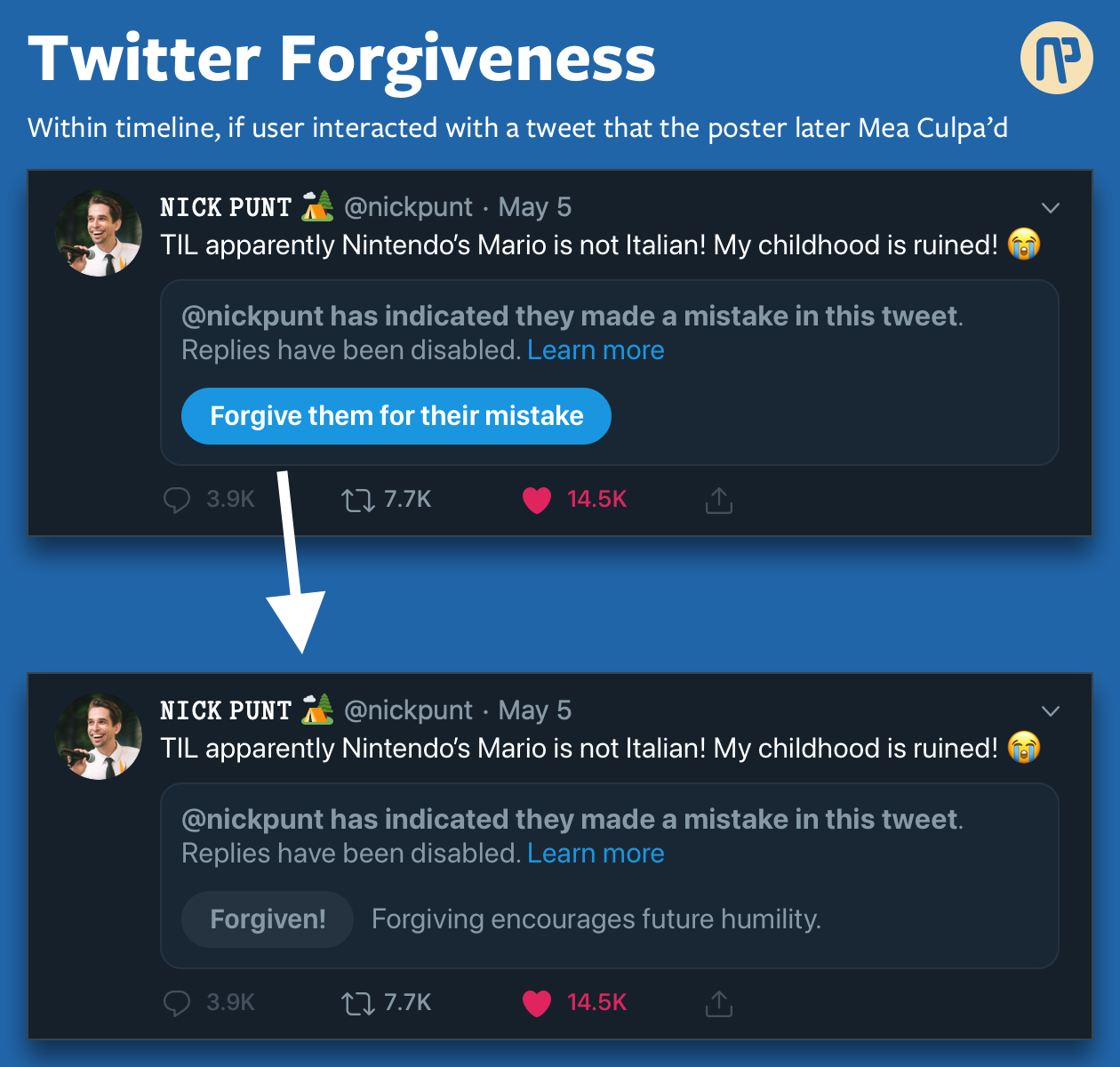Social media has a conflict problem.
Spending even a few minutes on public social media can expose us to dozens of people we know little about, talking about things we know little about. In such a public place, any individual's reputation, perspectives, and history are difficult to ascertain, and therefore their words must be taken at face value. Coupled with an almost complete lack of standards for participation in the community and a high degree of variance in knowledge among participants, and the environment naturally skews toward conflict and tribalism.
One particular effect of this environment is that small misunderstandings, mistakes, or disagreements can unexpectedly explode due to the public nature of discourse and assumptions of bad faith. Meanwhile, very few tools exist to moderate these effects.
This is why it's my belief that as designed today, social media is out of balance. It is far easier to escalate than it is to de-escalate, and this is a major problem that companies like Twitter and Facebook need to address.
This got me thinking about what particular use cases need de-escalation, and whether there's something simple we can do to test the waters and address these types of problems.
Target Use Case: Admitting Mistakes
One obvious issue is that people are wrong about a lot of things, but struggle to admit their mistakes. This is why many cultures have created elaborate norms around face-saving. Unfortunately, social media largely lacks these cultural norms, and even makes the problem worse in three ways:
- No social proof - Admitting mistakes is quite difficult if nobody else is seen (genuinely) admitting mistakes, as we rely heavily on social proof to sense-make around norms. An escalation-oriented culture means there's less genuine "I was wrong" on social media than there should be.
- No respite - as the visibility of a mistake travels across social media, the poster is subject to a constant deluge of new readers calling them out, with the combined energy of the outraged far exceeding that of the poster. This prevents them from having the necessary emotional cool-down period to respond thoughtfully.
- Digging in - when feeling personally attacked, its human nature to prefer to dig in rather than apologize. Social media's escalation-oriented culture plays into this human fallibility.
Take Twitter as an example environment. If we write something that turns out to be wrong and a pile-on begins, we're going to be swimming upstream fighting it. Our options are:
- Ignore replies and hopefully let it die out
- Delete your tweet, posting another tweet saying "I was wrong"
- Reply to your tweet, posting "I was wrong"
However, none of these are great. If we ignore replies, the simple amplification effects of likes, replies, retweets, and subtweets leave us exposed and the situation can get out of hand. If we delete and post another, people are unlikely to see our follow-up, as corrections are rarely viral. Similarly, even if we reply, only our viral mistake will be seen in the feed of others.
Let's also not forget the human tendency to not fully walk back statements, and instead offer unsatisfying explanations that can accidentally further enflame situations. Blaming, justifying, minimizing, or excusing are all self-sabotaging ways that people qualify their apologies to preserve their self-esteem or resolve their own cognitive dissonance, and social media is right there ready to give us this kind of rope to hang ourselves with when we're under assault.
In all these cases, a person's reputation in the minds of others is damaged because social media engagement engines favor the drama of the mistake over the correction and reconciliation, which leads few people to see or remember anything other than the mistake.
This seems like a perfect use case to design for, so I came up with a little design change I call the Twitter Mea Culpa.
Design Exploration: Twitter Mea Culpa
Twitter Mea Culpa is a way for a poster to flag their tweet as a mistake and de-escalate a situation, using the same action menu that deleting a post uses, and the same visual design as flagged tweets:

Clear Language

I picked this language carefully for several reasons:
- Create separation between the individual and what they say (the specific post), which reduces ego threat.
- Use an active voice to indicate responsibility (I made a mistake not Mistakes were made).
- Indicate the poster was the one who chose to flag the post, not Twitter or any other user, to reduce the impression to other users that the poster was censored.
- State the mistake unequivocally and leaving no room for ambiguity about whether it is actually a mistake, to reduce inauthentic use and self-sabotage.
- Avoid direct use of 'sorry' or 'I apologize' language, because for some people these words are extremely emotionally challenging to use.
Disable Amplification

Much like rules violations, once a user admits a mistake, the Mea Culpa tweet is no longer amplified. This means:
- The tweet is no longer made visible on everyone's home feed
- Users cannot reply, like, or retweet without comment
- Users may retweet with comment, to allow users to amplify the correction (e.g. I thought this wasn't the case, looks like they realized it)
By admitting a mistake, the poster stops the runaway train of replies and amplifications of their mistake, and the reputation damage that follows. In other words, Mea Culpas are intentionally designed to favor respectful debate and ability to cool off over maximal information exchange.

This amplification disabling is how rules violations work today. However admitting a mistake is much more innocuous, so I would recommend that existing replies, retweets, and likes remain accessible, which is not the case with violations. After all, sometimes mistakes can create interesting conversation.
Surface Corrections
One possible exception to the disable amplification rule is that a Mea Culpa tweet could show up again within the home feeds of users who originally reacted to it. This would basically be like issuing a correction, which would be intended to help limit accidental falsehoods from spreading.

For instance, if someone tweeted an unsubstantiated rumor and we liked or replied to it, when we go back to our home feed a day or two later we'd see their tweet with the notice that they'd made a mistake.
This seems like the right thing to do, and a way to help social media stay more focused on truth.
Culture of Use
Twitter Mea Culpa is meant to solve for a few specific use cases that involve the poster's authentic desire for de-escalation at some level:
- I'm actually wrong - when the poster knows they are wrong and wants to stop hearing from people and just correct their mistake.
- I'm right if you look at it this way - when the poster is struggling to understand in what ways or from what perspectives they're wrong, but can tell they are a little bit wrong, and are considering explaining themselves.
- Fine, I give up - when the poster is struggling to apologize or admit they're wrong, as is often the case when people feel vulnerable or when their ego is bruised, and are starting to think it might be better to tap out than to continue.
Today, the I'm actually wrong case is an obvious flaw in the system, where posters have to constantly reply to people saying "yeah, I know, I know, I was wrong, look at my other tweet". In this case, their reputation is less at risk and they're already at a point of emotional acceptance, so it's simply a matter of resolving unnecessary UX friction.
The much more interesting and subtle cases are I'm right if you look at it this way and Fine, I give up. Posters in these situations may not yet have the emotional distance to gain proper perspective, still feeling a connection between what they said and who they are (ego threat). As mentioned before, the lack of respite in social media can keep people in this emotional state for a lot longer than they might otherwise be, as each new notification they receive keeps them in a state of alert.
In these situations, there's an emotional temptation to respond when it's often best not to, given the escalating nature of the medium. The temptation comes from a poster having only one tool at their disposal to repair their reputation: replying to the tweets contributing to their threatened feelings.
With Mea Culpa, users gain a second tool specifically designed to de-escalate, that only requires their acknowledgement that a) they may be at least partly wrong, and b) they do not wish to continue. When in use, it can cut off potentially escalating conversations early, giving everyone else who sees the tweet the signal to step back because the poster may not have meant it and (at least partially) admits their mistake.
There is no guarantee that most or all conversations would de-escalate after a Mea Culpa, but in imagining the possible uses for it, I think it would help considerably.
Correcting for Inauthenticity
Unfortunately, there are also many bad faith actors on social media, and there's potential for any feature to be used in a way that means something other than what was intended, creating a culture of alternate use and meaning. A few anti-patterns may emerge here:
- Growth hacking - a user posts something intentionally fabulist they want others to see, get a lot of engagement, and then post a mistake tag to try to have people see it again.
- Ironic opposite - a user flags everything they post as a mistake, either in protest or just as an ironic statement.
- Just kidding - a user posts something boundary-pushing to float it as an idea, then walks it back with a mistake tag.
- I had to do it - a user posts something boundary-pushing that they believe, then walks it back with a mistake tag as a wink-and-nod to their audience signaling they still believe it.
- Outright abuse - a user posts something abusive about someone as a sort of sub-tweet, or tags them in it, then adds a mistake tag to absolve themselves of responsibility.
Of these, the de-amplification built in suggests Growth hacking is unlikely to work particularly well, and the Ironic opposite, Just kidding, and I had to do it posts are difficult to meaningfully correct for. Outright abuse always must be seriously considered, but I can see the Report Tweet feature may still work fine with it, perhaps by adding a case specifically around false mistakes.
Because of these anti-patterns, I wouldn't treat Mea Culpa tweets any differently or with additional discount than regular tweets when it comes to the Report Tweet feature. In other words, a tweet that garners lots of reports and violates Twitter rules should be taken down whether or not the author later Mea Culpas.
Follow-ups
Much like how you can retweet or retweet with comment, one optional feature could be include a followup statement:

While this seems like an obvious feature at first blush, unfortunately follow-ups may wind up promoting explanations that undermine the Mea Culpa's unequivocal meaning and de-escalatory power. This makes the culture of use of Mea Culpas more vulnerable to inauthenticity, leaving room for half-hearted / semi-abusive / vice-signaling walk backs. As mentioned above, explanations also makes it possible for people to sabotage themselves with poorly constructed apologies at the exact moment that they're feeling vulnerable and their pride and ego are threatened. It's probably not wise for either of these to be tied to a low-friction, high-amplification UX path.
For these reasons, I wouldn't launch with a follow-up feature; instead, I'd let the culture of unequivocal use set in for a while before even considering it.
Forgiveness
Back to basics though, another part of admitting mistakes is the other side: offering forgiveness. This is another pro-social behavior, because receiving forgiveness is positive reinforcement that creates a safer place which makes us more likely to admit a mistake in the future. So how about we add a forgive button:

In this mockup I didn't include a social proof forgiveness count. In some ways I like forgiveness being a more personal choice, but social proof is also useful. The forgive button may also only need to appear for those that reacted to the Mea Culpa'd tweet (a sort of no harm, no foul minimalist approach to design).
I think it's also interesting to explore how the poster receives the forgiveness notification. Simply counting forgiveness in the way that Twitter likes work isn't the best way to restore lost reputation between people. Instead, I would bundle forgiveness with prior interactions between individuals. Take this example:
- Poster tweets something wrong, perhaps offensive to some
- User replies saying "that's not cool, you know thats not the case"
- Poster Mea Culpas, flagging their tweet as a mistake
- User indicates forgiveness
This is an example where you'd want the entire exchange to be tied together into one notification, rather than unbundled into things like 12 people forgave you for this tweet, while having to hunt down a particular user whose response you valued. Bundling the whole interaction together reflects how reputation and forgiveness actually work between individuals, so we should see exactly that in the UI.
However, for tweets with significant activity (dozens to hundreds of replies), there may still need to be some UI collapsing needed, perhaps behind a 'show more' menu for forgiveness replies received within a given block of time.
Goals and Measurement
Finding the right measure of success in any feature rooted in human psychology is challenging, and even more so in complex systems like social media. No matter what, people are going to say things that are wrong or offensive on social media. The question is, how do these mistakes wind up affecting the broader community? Does it start a forest fire of escalation, or burn out quickly, or even create a teachable moment where everyone is better off?
The goal of de-escalating social media is to create more a civil and productive environment where good faith is assumed, and this starts within the relationship between two people. Ideally, even if two people disagree, we want them to walk away with some level of respect for each other. A few potential measurable questions arise from this.
Are Mea Culpas being used in the right circumstances?
One way to look at the problem is how potentially damaging the interaction between two people winds up being after a user posts something that is likely to require a Mea Culpa. It's likely very difficult to tell whether a tweet actually requires a Mea Culpa, because divisiveness and disagreement are part of the public conversation (most especially in politics). Tweets could be algorithmically flagged as having potential for Mea Culpas based on their replies, but this may be extremely noisy.
Sentiment analysis and individual post history may be a guide to answer this question. If one user normally has good interactions with another, but then posts something that results in a negative response from the other, this could be a way to get higher signal on a potential Mea Culpa tweet. The percent of these posts that reach a certain sentiment threshold and wind up being Mea Culpa'd and then forgiven would be one way to look at this.
Are people being forgiven enough, specifically people who follow each other?
Another way to look at this is of tweets that received a negative sentiment reaction by a user that resulted in the poster admitting mistake, and that the user saw the Mea Culpa in their home feed, what % of those users wound up forgiving the poster? This may tell us the perceived authenticity of the poster's Mea Culpa and thus the user's acceptance of it, but it may be confounded by whether the user even understands the forgiveness feature.
When Mea Culpas are used, do people continue to interact?
A third way may be to not worry about how much the Mea Culpa feature is used, and simply focus on the effects of its use. In this case, the measure might be what % of users that forgive posters that admit mistakes wind up continuing to follow the poster after 30-90 days, or interact with them after 30-90 days? If they continue to do both, the assumption is the relationship is fine, and if it increases, it may be that the disagreement led to a closer bond.
What level of measurement even matters
There are a lot of ways to measure things quantitatively in social media. However constructing these bits into higher level pro-social goals that align with human interest can be difficult, if not downright impossible at times. As the famous Einstein quote goes, "not everything that can be measured matters, and not everything that matters can be measured". Metrics are not always required to justify new features. It may be enough that features have value merely by their presence suggesting a different tone be struck in the community, or through qualitative observation of how they're being used.
How Mea Culpa Relates to Editing Tweets
Despite strong user interest, Twitter has been pretty adament about not allowing edits to tweets. I'm in agreement with their position, mainly because editing introduces a lot of complexity and unintended abusive effects.
The big abuse example is if a user likes or retweets something that was later edited to mean the opposite. Because Twitter is a much more public forum than Facebook and heavily uses likes and retweets to promote content and discovery, edits are really much more likely to be abused than on Facebook (where the feature exists).
However, one important use case for editing is admitting mistakes. There's more than one way to skin a cat though, as Mea Culpas show. If Twitter introduces Mea Culpas, it will reduce some user pressure for editing tweets.
Even if Twitter winds up introducing editing though, I think it makes sense to build Mea Culpas. Not only is it a lot easier to press a 'I made a mistake' button than it is to choose what kind of walk-back you want to type out, it makes the acknowledgement of the mistake more unequivocal which reduces self-sabotage, and its special status encourages others to use the feature and change their behavior.
Another way to look at it is that admitting a mistake is not just a bag of words in a reply - it's a special case of human interaction that needs UX prominence that aligns to its importance in human society. And as with all things UX, features that are easier to use wind up being used more, and features used more wind up changing the culture and norms of how the product is used.
Summary
In summary, the Mea Culpa idea involves three changes on Twitter:
1. Add the ability to admit a mistake, which shuts down tweet amplification
2. Add corrections in the home feeds of those who reacted to it, which helps inform readers so they may adjust what they feel about the poster and may become better informed
3. Add a way to forgive the poster for those who reacted, which creates an incentive to admit mistakes in the future, and helps repair any relationship damage between people
I think these changes would make Twitter a kinder and more respectful place, and I hope they implement something like this.
Final thoughts
We have to acknowledge that the tools offered on social media today are too simplistic to capture the nuance of human social interactions, and a culture has emerged within these mediums that reflects their inherent imbalance.
In the coming decade, social media needs to figure out how to get back in balance, by exploring designs that help build understanding, find resolution to conflict, and offer paths for restorative justice. These designs need not be earth shattering - some may be quite simple, as in the Mea Culpa example above.
If social media simply continues down the path of imbalance, offering only band-aid solutions like content moderators and simple reporting tools atop an engine of conflict escalation, we're going to continue to find society reflecting and internalizing the division these mediums create. Instead, we need deeper product changes that reduce conflict escalation in the first place, and this requires exploring a different set of potential solutions.
Get in touch if you like my work.
Additional lively discussion on this over at Hacker News.
Post image by Patrick Garcia, Agni Kai scene from Avatar: The Last Airbender
